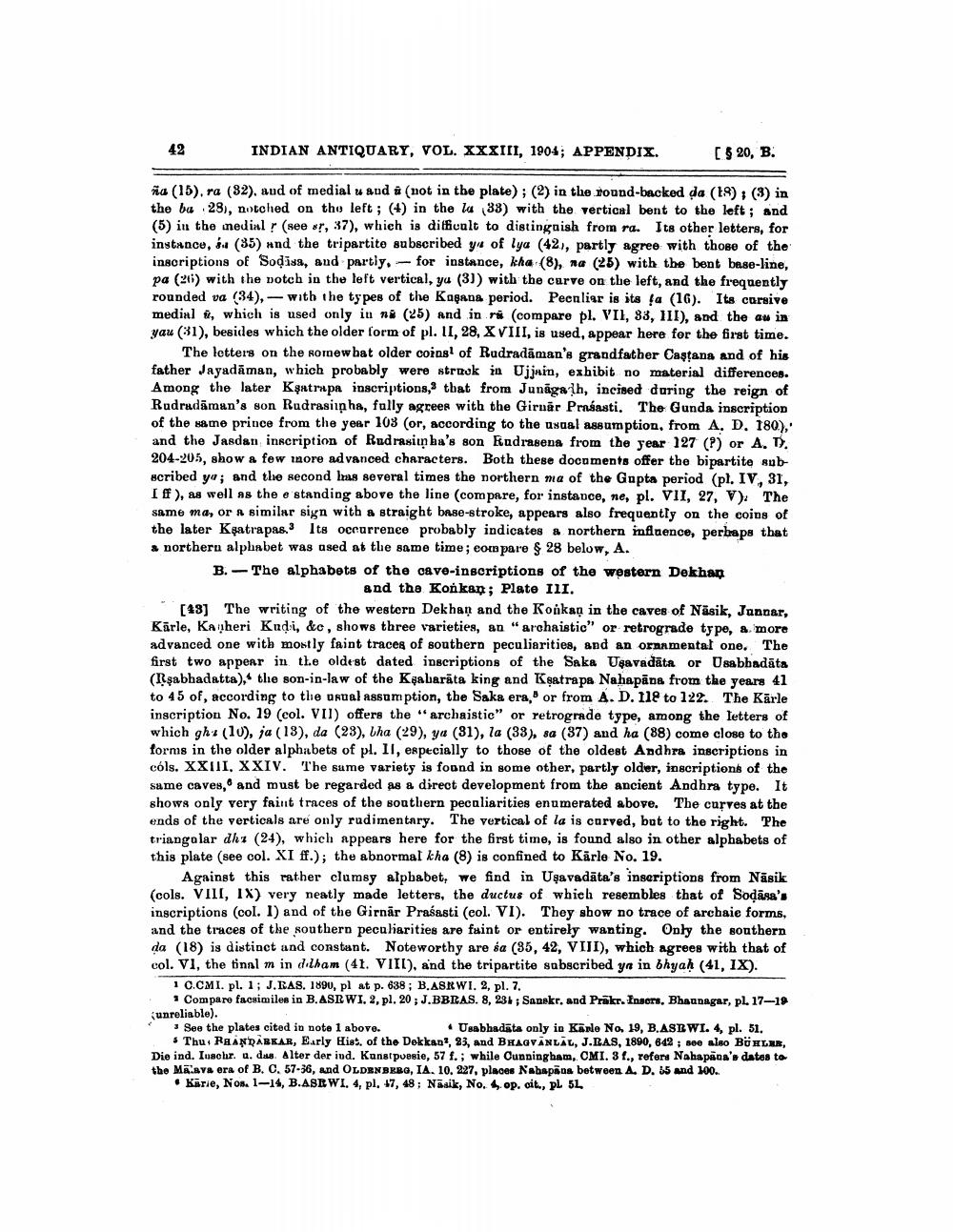________________
42
INDIAN ANTIQUARY, VOL. XXXIII, 1904; APPENDIX.
[620, B.
ña (15), ra (32), aud of medial u sud a (not in the plate); (2) in the round-backed da (18) : (3) in the bu 28), notched on the left ; (4) in the la (38) with the vertical bent to the left; and (5) in the inedial (see sr, 37), which is difficult to distinguish from ra. Its other letters, for instance, ó (35) and the tripartite subscribed yu of lya (42), partly agree with those of the inscriptions of Sodisa, aud partiy,- for instance, kha (8), na (25) with the bent base-line, pa (20) with the votch in the left vertical, yu (3)) with the carve on the left, and the frequently rounded va (34), - with the types of the Kaçana period. Peenliar is its fa (16). Its carsive medial , which is used only in nå (25) And in rå (compare pl. VII, 83, III), and the au in yau (31), besides which the older form of pl. II, 28, XVIII, is used, appear here for the first time.
The letters on the momew bat older coins of Rudradāman's grandfather Castana and of his father Jayadāman, which probably were struok in Ujjain, exhibit no material differences. Among the later Kşatrapa inscriptions, that from Junagah, incised during the reign of Rudradāman's son Rudrasiinha, fully agrees with the Girnar Prasasti. The Gunda inscription of the same prince from the year 103 (or, according to the usual assumption, from A, D, 180), and the Jasdan inscription of Rudrasitha's son Eudrasena from the year 127 (?) or A. D. 204-205, show a few inore advanced characters. Both these documents offer the bipartite sub scribed yo; and the second lmas several times the northern ma of the Gupta period (pl. IV, 31, I ff), as well as the e standing above the line (compare, for instance, ne, pl. VII, 27, V), The same ma, or a similar sign with a straight base-stroke, appears also frequently on the coins of the later Katrapas. Its occurrence probably indicates a northern influence, perhaps that a northeru alphabet was used at the same time; compare $ 28 below, A. B. - The alphabets of the cave-inscriptions of the western Dekhan
and the Konkan; Plate III. [49] The writing of the western Dekhan and the Konkan in the caves of Näsik, Jannar, Kärle, Kavheri Kudi, &c, shows three varieties, an "archaistic" or retrograde type, a more advanced one with mostly faint traces of southern peculiarities, and an ornamental one. The first two appear in the oldest dated inscriptions of the Saka Ugavadāta or Usabhadāta (Rşabhadatta), the son-in-law of the Kaabarāta king and Katrapa Nahapāna from the years 41 to 45 of, according to tlie urual assumption, the Saka era," or from A. D. 118 to 122. The Kārle inscription No. 19 (col. VII) offers the "archaistic" or retrograde type, among the letters of which ghé (10), ja (18), da (23), lha (29), ya (31), la (33), sa (37) and ha (88) come close to the forms in the older alphabets of pl. II, especially to those of the oldest Andhra inscriptions in cóls. XXIII, XXIV. The sume variety is found in some other, partly older, inscriptions of the same caves, and must be regarded as a direct development from the ancient Andhra type. It shows only very faint traces of the southern pecaliarities enumerated above. The curves at the ends of the verticals are only rudimentary. The vertical of la is carved, but to the right. The triangular dhı (24), which appears here for the first time, is found also in other alphabets of this plate (see col. XI ff.); the abnormal kha (8) is confined to Kārle No. 19.
Against this rather clumsy alphabet, we find in Uşavadāta's inscriptions from Nāsik (cols. VIII, IX) very neatly made letters, the ductus of which resembles that of Sodāsa's inscriptions (col. I) and of the Girnār Prasasti (eol. VI). They show no trace of archaie forms, and the traces of the southern peculiarities are faint or entirely wanting. Only the southern da (18) is distinct and constant. Noteworthy are sa (35, 42, VIJI), which agrees with that of col. VI, the final m in dilham (41. VIIT), and the tripartite subscribed ya in bhyah (41, IX).
1 C.CMI. pl. 1 ; J.RAS. 1890, pl at p. 638; B.ASRWI. 2, pl. 7.
Compare facsimiles in B.ASRWI. 2. pl. 20; J.BBRAS. 8. 231; Sanskr, and Prükr. Insors, Bhavnagar, pl. 17-19 (unreliable). See the plates cited in note 1 above.
Usabhadita only in Kärle No. 19, B.ASRWI. 4, pl. 51. Thu: RAANDABKAR, Early His, of the Dekkan?, 33, and BHAGVANLAL, J.RAS, 1890, 642 ; see also BÖHLAR, Die ind. Luachr. u. das Alter der ind. Kunstpoesie, 57 f. ; while Cunningham, CMI. 3 f., refera Nahapana's dates to
1-36, and OLDENBERG, IA. 10. 227, places Nabapaus between A. D. 55 and 100.. • Karie, Nos. 1-14, B.ASEWI. 4, pl, 47, 48; Näsik, No, op. cit., PL 5L




